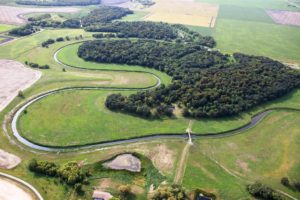The legendary Supreme Court Chief Justice Oliver Wendell Holmes, Jr. once said, “Taxes are the price we pay for civilization. I like to pay taxes. With them I buy civilization.” These days, they are increasingly buying restoration.
Unfortunately, major corporations have been funding the campaigns of many politicians in order to get them to remove regulations that prevent them from polluting the air and water, poison our food, and scam investors via the banking systems. They do this under the guise of “small government”, which sounds good on the surface, but is basically code for “no protection for the public.” They’ve made “regulation” a dirty word, even the the sole purpose of a regulation is to protect citizens.
Along with this “small government” sales pitch comes “less taxes”, which is an easy sell to those who are ignorant of how they benefit from taxation. The result is that these small government advocates have become the new “welfare queens”: they want something for nothing. They want a great country, but aren’t willing to pay for it.
But not all Americans are freeloaders. In the April 15, 2018 issue of REVITALIZATION, we had an article about how San Francisco is enjoying the cleanup and restoration of San Francisco Bay, thanks to their highly-responsible decision to tax themselves in order to pay for it. Their children will thus enjoy a future where swimming in the Bay will be less likely to give them cancer, and where rebounding fish popuations will boost revenue from both recreational and commercial fishing.

Grand Marais Creek restored to its natural serpentine shape after a century of being turned into a linear ditch.
In Minnesota, citizens were equally intelligent and responsible. In November of 2008, they passed the Clean Water, Land and Legacy Amendment, voting for a three-eighths of 1% tax increase (4 cents per $10 purchase) over the next quarter-century to pay for wildlife habitat restoration, cleaner water, plus renovated parks and trails.
This decision came during elevated gasoline prices and the tragic Bush recession, making the decision especially courageous. But, as with San Francisco Bay, it’s paying off nicely.
Grand Marais Creek was destroyed in 1905, when a mile-long drainage ditch was dug to divert water from the creek’s 300-square-mile drainage area and send it directly into the Red River.
Local folks have been dreaming of undoing that engineering mistake and restoring a 6½ mile stretch of the creek for years–to restore crucial wetlands and improve flood control—but never had the money. But in 2015, the Grand Marais Creek restoration project was completed at a cost of $6.2 million, thanks to the Clean Water, Land and Legacy funds.
Today, the restored creek is a haven for deer, waterfowl and upland birds, and the clear water that flows into the Red River is nearly sediment-free.
To reverse 100 years of erosion damage, the project restored the physical and hydrologic characteristics of this six-mile reach of original natural channel. A diversion structure redirected flows from the drainage ditch and restored them to the natural channel. The restored hydrology sustains aquatic habitat and nearly 400 acres of wetland and prairie native vegetation habitat along the Grand Marais Creek corridor.
The project targeted restoring habitat to a variety of spawning and juvenile fish species and waterfowl, as well as restoring a permanent and seasonal riparian ecosystem for aquatic and terrestrial plant and upland animal species. Healthy channel connectivity now exists between the Red River and upstream riverine and wetland habitats within the Grand Marais Creek subwatershed.
This project provided a unique opportunity for the local landowners, state and local governments to come together and develop a solution to a long-standing land management and environmental problem collaboratively. Because of the significant size of the project (6 miles of channel restoration), and the effects to a significantly large watershed (excess of 300 square miles), a tremendously diverse group of stakeholders and interests had to be managed throughout the project.
The District used the project team approach to engage these interests in developing the project features and to create solutions along the way. This project serves as a model in the Red River Valley on how to manage and construct large river restoration project segments that maintain the social, economic, and natural resource values for the local community.
All project construction, including the final diversion dam was completed in the summer of 2015. The new project has restored six miles of natural stream channel habitat, restoring connectivity between more than 20 miles of stream habitat and the Red River of the North. This will provide seasonal fish spawning and nursery habitat, which will increase the resiliency of the river’s ecosystem.
Restoring hydrologic and hydraulic conditions to the Grand Marais Creek required the restoration of nearly 400 acres of marginal agricultural land to a functional native vegetation habitat. This involved a mix of prairie floodplain, riparian wetlands, and natural channel within Minnesota’s prairie eco region.
Photos courtesy of Houston Engineering.

